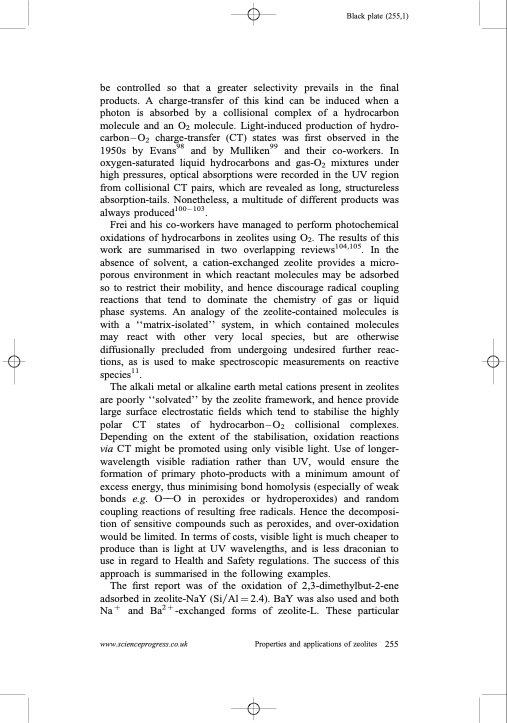
PDF Publication Title:
Text from PDF Page: 033
Black plate (255,1) be controlled so that a greater selectivity prevails in the final products. A charge-transfer of this kind can be induced when a photon is absorbed by a collisional complex of a hydrocarbon molecule and an O2 molecule. Light-induced production of hydro- carbon – O2 charge-transfer (CT) states was first observed in the 1950s by Evans98 and by Mulliken99 and their co-workers. In oxygen-saturated liquid hydrocarbons and gas-O2 mixtures under high pressures, optical absorptions were recorded in the UV region from collisional CT pairs, which are revealed as long, structureless absorption-tails. Nonetheless, a multitude of different products was always produced100–103. Frei and his co-workers have managed to perform photochemical oxidations of hydrocarbons in zeolites using O2. The results of this work are summarised in two overlapping reviews104,105. In the absence of solvent, a cation-exchanged zeolite provides a micro- porous environment in which reactant molecules may be adsorbed so to restrict their mobility, and hence discourage radical coupling reactions that tend to dominate the chemistry of gas or liquid phase systems. An analogy of the zeolite-contained molecules is with a ‘‘matrix-isolated’’ system, in which contained molecules may react with other very local species, but are otherwise diffusionally precluded from undergoing undesired further reac- tions, as is used to make spectroscopic measurements on reactive species11. The alkali metal or alkaline earth metal cations present in zeolites are poorly ‘‘solvated’’ by the zeolite framework, and hence provide large surface electrostatic fields which tend to stabilise the highly polar CT states of hydrocarbon – O2 collisional complexes. Depending on the extent of the stabilisation, oxidation reactions via CT might be promoted using only visible light. Use of longer- wavelength visible radiation rather than UV, would ensure the formation of primary photo-products with a minimum amount of excess energy, thus minimising bond homolysis (especially of weak bonds e.g. O2O in peroxides or hydroperoxides) and random coupling reactions of resulting free radicals. Hence the decomposi- tion of sensitive compounds such as peroxides, and over-oxidation would be limited. In terms of costs, visible light is much cheaper to produce than is light at UV wavelengths, and is less draconian to use in regard to Health and Safety regulations. The success of this approach is summarised in the following examples. The first report was of the oxidation of 2,3-dimethylbut-2-ene adsorbed in zeolite-NaY (SiyAl 1⁄4 2.4). BaY was also used and both Na þ and Ba2 þ -exchanged forms of zeolite-L. These particular www.scienceprogress.co.uk Properties and applications of zeolites 255PDF Image | Properties and applications of zeolites

PDF Search Title:
Properties and applications of zeolitesOriginal File Name Searched:
003685010x12800828155007.pdfDIY PDF Search: Google It | Yahoo | Bing
CO2 Organic Rankine Cycle Experimenter Platform The supercritical CO2 phase change system is both a heat pump and organic rankine cycle which can be used for those purposes and as a supercritical extractor for advanced subcritical and supercritical extraction technology. Uses include producing nanoparticles, precious metal CO2 extraction, lithium battery recycling, and other applications... More Info
Heat Pumps CO2 ORC Heat Pump System Platform More Info
| CONTACT TEL: 608-238-6001 Email: greg@infinityturbine.com | RSS | AMP |